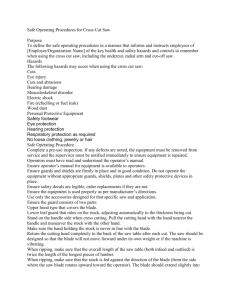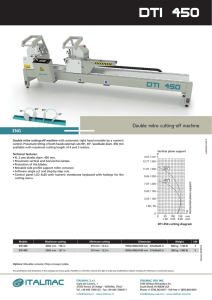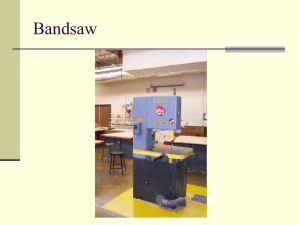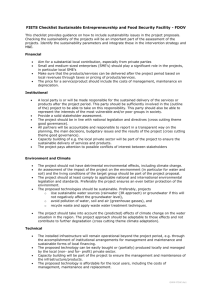Operation of DISCO DAD3230 automatic dicing saw
advertisement
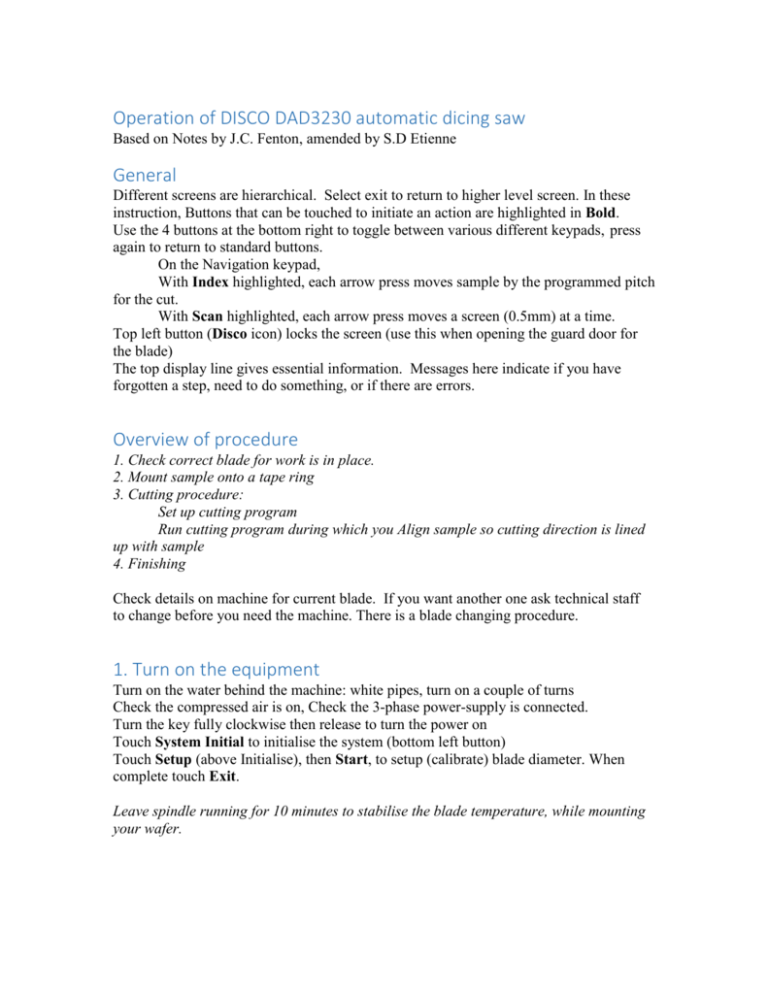
Operation of DISCO DAD3230 automatic dicing saw Based on Notes by J.C. Fenton, amended by S.D Etienne General Different screens are hierarchical. Select exit to return to higher level screen. In these instruction, Buttons that can be touched to initiate an action are highlighted in Bold. Use the 4 buttons at the bottom right to toggle between various different keypads, press again to return to standard buttons. On the Navigation keypad, With Index highlighted, each arrow press moves sample by the programmed pitch for the cut. With Scan highlighted, each arrow press moves a screen (0.5mm) at a time. Top left button (Disco icon) locks the screen (use this when opening the guard door for the blade) The top display line gives essential information. Messages here indicate if you have forgotten a step, need to do something, or if there are errors. Overview of procedure 1. Check correct blade for work is in place. 2. Mount sample onto a tape ring 3. Cutting procedure: Set up cutting program Run cutting program during which you Align sample so cutting direction is lined up with sample 4. Finishing Check details on machine for current blade. If you want another one ask technical staff to change before you need the machine. There is a blade changing procedure. 1. Turn on the equipment Turn on the water behind the machine: white pipes, turn on a couple of turns Check the compressed air is on, Check the 3-phase power-supply is connected. Turn the key fully clockwise then release to turn the power on Touch System Initial to initialise the system (bottom left button) Touch Setup (above Initialise), then Start, to setup (calibrate) blade diameter. When complete touch Exit. Leave spindle running for 10 minutes to stabilise the blade temperature, while mounting your wafer. 2. Mount sample onto a tape ring with Powatec Wafer mounter Turn on power to Powatec tape winder. Remove chuck cover. Blow dust off the chuck with the compressed air gun Place a metal frame on the mounter, lining up with the pins and the drawn outline Place sample face down on the chuck so that the main cutting directions are parallel or perpendicular to the front. Centre and rotationally align the sample as well as possible. Check rear surface is free from particles and contamination To dice several samples at once mount samples with diagonal offset symmetrically around centre of frame, with a clear gap (10mm) between samples along horizontal and vertical directions Adjust stage height as necessary (with rotating knob underneath) so the roller touches the back of the sample as you roll it over the frame Slowly pull out fresh UV tape while checking that the backing tape is pulled off by the motor, then attach the UV tape to front black bevelled edge. Use roller to roll from front to rear, all bubbles should be eliminated from the sample. Lower circle cutting tool and cut through tape on frame by rotating at least 5 times. Cut tape at the slot at rear of mounter with a scalpel, then remove excess tape. May need to use scalpel to manually complete cuts. Measure sample dimensions with a ruler so you know the area in which cuts are to be made (note this is for a circle/square centred in the middle of the frame) Decide how many cuts need to be made in each direction and note this down. The UV tape stops being sticky when exposed to UV light; 12 minutes of exposure on UV box is sufficient. 3. Cutting procedure Load actual sample into machine Slide open right hand door, Load frame with sample on, pushing it against the pins at the back Touch C/T vacuum, to turn on chuck table vacuum and confirm that the vacuum gauge shows green, then close door fully Load cutting program Main menu > Device Data > Data select load a pre-saved program (or create a new one) Set work thickness (150um tape is standard) Set cut mode A, and REAR cutting direction Blade height is height after the cut: 120um will cut 30um into 150um tape Adjust work area if necessary, so that the whole sample is within the work area (note the work area is a circle or rectangle centred in the middle of the frame) Each Channel is a cutting direction, containing multiple parallel cuts. Normally Channel 1 is set at 0 degrees and channel 2 is set at 90 degrees. Up to 4 channels can be programmed, with any angle defined for each. Choose cut mode Select: Main menu > Manual Operation, then either Cutting auto: aligns and cuts all the pre-programmed Channels Cutting semi-auto: aligns and cuts in only the first channel programmed (use this if you want to cut in only one direction) Manual alignment Select: Manual alignment button Select Light, adjust direct light level, to get a mid gray overall intensity. Adding oblique lighting can show up edges (e.g. cuts) better then Exit Select Focus > Autofocus. Autofocus does not always work if the lighting settings are a long way out or the sample is featureless. Move to an area with features or readjust light. Touch Exit. Rotational alignment: Pay attention to the prompt at the top of the screen Note Theta alignment process always requires the Theta Align button to be pressed twice, once on the left and once on the right end of the alignment feature. If you omit one press or accidently press it twice in the same position, a random angle will be entered which will not be what you need. 1. Prompt should be “Perform theta alignment” (or “Match hairline to street and press enter”). Locate a known feature towards the left-hand side of the sample which is parallel to the cutting direction and move vertically to align with the central green marker. Press “Align theta” 1st time (this registers the left position, and then should scan to a point on the right-hand side of the work area) 2. Prompt should be “Select a target for theta adjustment and press F5” Move sample to line up the feature to the same up/down position as the first point (use Index navigation feature move sample left or right if machine has scanned too far off the edge of the sample, or not scanned )) press “Align theta” 2nd time to store this adjustment (this will scan back to the first position set on the left-hand side of the sample and will adjust stage rotation) 3. Repeat steps 1 and 2 until pressing align theta moves stage exactly along the desired cutting direction 4. Check that the prompt is “Match hairline to street and press enter”: move to line of first cut (remember subsequent cuts will be made to the rear (i.e. up on the screen) compared with this one. adjust up/down so cut is in right place narrow/widen dotted hairlines is helpful for centring the line check by using index navigation that cuts will be made in the desired positions if desired, reduce number of cuts from that specified in the program 5. Press enter. This will rotate to the next channel angle (typically 90 degrees) and you need to repeat the steps 1-5 for this channel. When all channels have been aligned, pressing Enter will move to Cutting Screen Cutting Press start to initiate the automatic process, which will proceed to completion. Note: To abort cutting: Press START/STOP to stop the program after the present cut or Z-EM (top left) to stop cutting immediately An alarm sounds at the end of the cutting procedure; silence this with the top right button Alarm/clr 4. Finishing Main menu > C/T vacuum button moves sample to accessible position for removal Main menu > System initial (bottom left), wait for completion Turn key off Shut off water supply. Wait until computer is fully off and machine stops hissing then shut off compressed air. Notes: A) Design samples so that dicing-saw cuts will not go through any metal, as this clogs the blade. B) Leave a clear cutting track about 3x blade width wide (200 micrometres). C) Regular or continuous features each side of this track will greatly assist theta alignment and cutting position alignment. D) Avoid cutting along (i.e. at and parallel to) a sample edge, where a blade might be half in and half out of material, as this will break the blade.
